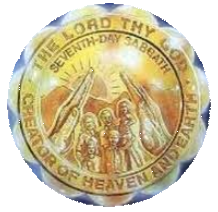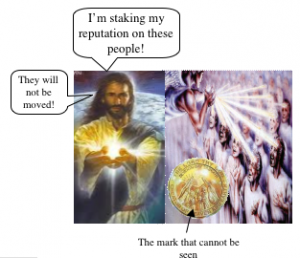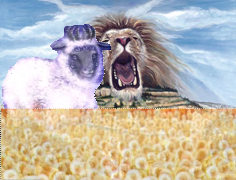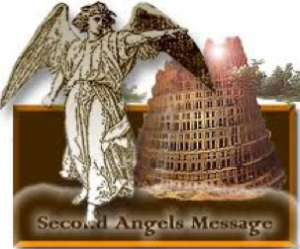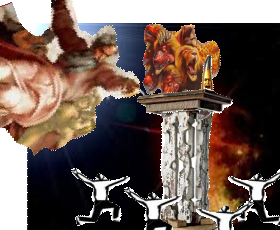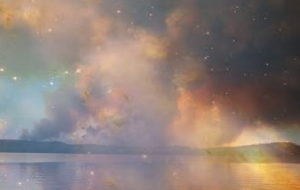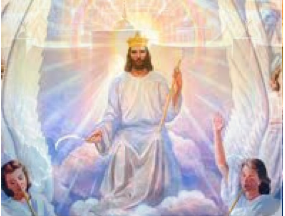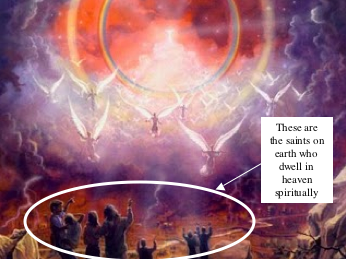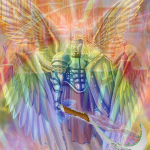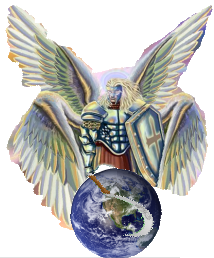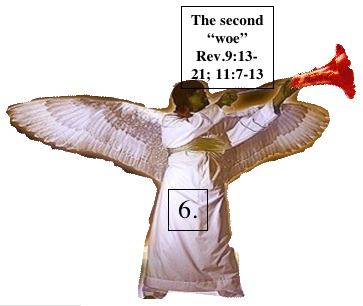By now, having studied Chapters 12 and 13, it should be evident that the progression format of the seven churches, seven seals and seven trumpets, outlined in Chapters 3-11, has changed into a format more like a review. Note again that the last church (Laodicea) brought in the seven seals. The last seal (the “seventh” of Chapter 8) brought in the seven trumpets. Chapter 12 then gives us a sweeping outline of the Great Controversy between good and evil. It first alludes to the true church, then points back into prehistoric time when there was “war in heaven” and ending with the last confrontation between the dragon and the church. In that outline, the two crucial phases of that final struggle are illustrated―the historic “Dark Age,” and the future “Dark age.” Therefore, from Chapter 13 and onwards to the end of the book of Revelation, we will see a focusing (or review and deeper insights) on many of the features of the seven churches, seals and trumpets.
Chapter 13 basically recapitulates the fifth seal scenario of Revelation 6:9-11 and ends with the terrifying “image of the beast,” its “mark” with economic sanction and the threat of death imposed upon all dissenters. In answer to the question posed in Revelation 6:17, “who shall be able to stand?” it would be easy to conclude: nobody would be “able to stand” against the “threefold union,” much less, be ready for the second coming of the “lamb.”
In contrast, this chapter brings good news. It, in essence, alludes to the ultimate victory of the “white horse” icon that goes “forth conquering,” and ultimately, “to conquer” (Revelation 6:2) once and for all. So, there will be those who “shall be able to stand,” not only when others call for “the mountains and rocks [to] fall on [them and] hide [them] from the wrath of the Lamb” (Revelation 6:17) but who will stand even though they cannot “buy or sell, save he that had [has] the mark, or the name of the beast, or the number of his name” (Revelation 13:17). Knowing that this will be “the test that the people of God must have before they are sealed” will certainly strengthen the resolve and courage of the saints as they face that daunting situation.
Although there are challenging aspects to Revelation 14, we are assured that “The fourteenth chapter of Revelation is a chapter of the deepest interest. This scripture will soon be understood in all its bearings, and the messages given to John the revelator will be repeated with distinct utterance.” [1] So, let’s do our best to understand it distinctly in order to be able to repeat it distinctly.
Verse 1 And I looked, and, lo, a Lamb stood on the mount Sion, and with him an hundred forty and four thousand, having his Father’s name written in their foreheads.
The last time John “looked,” he saw “a pale horse” whose rider “was Death, and Hell followed . . .” (Revelation 6:8). This time the scene is far more pleasant. The “Lamb,” last mentioned as being “slain from the foundation of the world” (Revelation13:8), is now seen standing on “mount Sion” which, in John’s time, was the site of the earthly tabernacle. However, that tabernacle had been laid in ruins by the Roman army some thirty years previously in 70 A.D. Therefore, “Sion” represents the new site of God’s government in heaven where Christ assumed His position and was “set down with [His] Father in his throne” (Revelation 3:21) in heaven. He took His position there after His ascension back in 31 A.D.
Now, He and His Father are not alone. With Him, in heaven, are the “hundred forty and four thousand” featured previously in the sixth seal scenario (Revelation 7:4-8). There, John only “heard the number” of them while he actually “beheld . . . a great multitude, which no man could number” (Revelation 7:4, 9). Here he actually sees the 144,000 in heaven with no mention of the “great multitude.” Nevertheless, we can assume the presence of the “great multitude,” that the 144,000 were a part of in Chapter 7. There, they are “before the throne” in heaven and, here, they are on “mount Sion,” also in heaven, soon after the second coming, and, we can assume, before the throne as well. John was told that the “great multitude . . . came out of great tribulation” (Revelation 7:14), the same “tribulation” that the 144,000 also “came out of.” [2]
Having studied the seven-trumpet scenario (Revelation 8:6), that began after Jesus cast down the censer (Revelation 8:5), we know that the “great tribulation” took place during the trumpet events. And we can also be assured that the 144,000, along with the “great multitude,” were able to “stand” throughout that time. But that’s not all. Bear in mind that the general resurrection of all the dead, who had died in Christ, did not take place until the last of the seven trumpets (the “third woe” of Revelation 11:14), had been sounded. Paul suggests: “For the Lord himself shall descend from heaven with a shout, with the voice of the archangel, and with the trump [“the last trump,” 1 Corinthians 15:52] of God: and the dead in Christ shall rise first:” (1 Thessalonians 4:16). Therefore, the resurrection takes place during the great consummation (when the Lord actually descends), the final event at the end of the trumpet scenario.
Reference to “having his Father’s name written in their foreheads” takes us back again to Chapter 7 where “four angels” were seen “standing on the four corners of the earth, holding the four winds of the earth” in order to protect the earth, sea and trees until the “servants of our God” could be sealed “in their foreheads.” But “even after the saints are sealed with the seal of the living God, His elect will have trials individually. Personal afflictions will come; but the furnace is closely watched by an eye that will not suffer the gold to be consumed . . . They are God’s property, His possession.” [3] To “be consumed” suggests that yielding to the trials and afflictions is still a possibility, even after being sealed! Therefore, their power of choice has not been removed―even with the “seal in their foreheads!” As a result, the “seal” simply means that God is prepared to stake His honor on the character and behavior of these men and women during post probationary time, when yielding in any way to affliction and trial would result in God’s defeat, and Satan’s victory, in that final stage of the Great Controversy. But God predicts that will not happen―not because it could not―but because the saints will refuse (by God’s sustaining grace) to yield. [4]
The prime example of just such a scenario is that of the man Job. God staked His reputation on Job when He suggested to Satan: “all that he hath is in thy power” and “he is in thine hand” (see Job 1:12; 2:6). God allowed Satan to afflict him to the max. He actually depended upon Job not to dishonor Him by sinning or to charge Him “foolishly.” So, God honored him greatly because He was staking His reputation before all the other “sons of God” (Job 1:6; 2:1) of the universe, depending on him to vindicate His name. What an honor! Job was only one man. In the case presented here (Revelation 7 & 14), God is clearly planning to put on a mass demonstration by according the same honor to the 144,000 and the “great multitude!”
Although John saw many who “were beheaded for the witness of Jesus, and for the word of God, and which had not worshipped the beast, neither his image, neither had received his mark upon their foreheads, or in their hands” (Revelation 20:4), the 144,000 were preserved alive. [5] Having no certainty that they would be kept alive, they too, had to face the very real possibility of being killed.
“Why were they [the 144,000] so specially singled out? Because they had to stand with a wonderful truth right before the whole world, and receive their opposition, and while receiving this opposition they were to remember that they were sons and daughters of God, that they must have Christ formed within them the hope of glory. They were ever keeping in view the great and blessed hope that is before them. What is it? It is an eternal weight of glory. Nothing could surpass it.” [6]
Their experience is represented by “the two candlesticks” seen “standing before the God of the earth (Revelation 11:4) proclaiming the “solemn warning,” during probationary time, to the whole world against “the mark of the beast.” Their effort filled “the earth with the knowledge of God . . . as the waters cover the sea.” [7] It appears that the success of their work will exceed all expectation. Check out Zechariah 13:8, 9: “And it shall come to pass, that in all the land, saith the Lord, two parts therein shall be cut off and die; but the third shall be left therein. And I will bring the third part through the fire, and will refine them as silver is refined, and will try them as gold is tried: they shall call on my name, and I will hear them: I will say, It is my people: and they shall say, The Lord is my God.”
Verse 2: And I heard a voice from heaven, as the voice of many waters, and as the voice of a great thunder: and I heard the voice of harpers harping with their harps:
Note, two voices are depicted here: “a voice from heaven” and “the voice of harpers.” The “voice from heaven” was last heard inviting the “two witnesses” to “Come up hither” (Revelation 11:12), and even before had told John to “seal up those things which the seven thunders uttered” (Revelation 10:4).
The second “voice,” depicted as “harpers harping with their harps,” and singing in the next verse, is that of “the hundred and forty and four thousand” who, in spite of singing and playing with all their might could not drown out the thunderous voice of Jesus as He celebrated with them over their great victory after having stood “with a wonderful truth right before the whole world” and receiving “their opposition” without murmur or complaint [8], just as Jesus did during His earthly ministry.
Verse 3: And they sung as it were a new song before the throne, and before the four beasts, and the elders: and no man could learn that song but the hundred and forty and four thousand, which were redeemed from the earth.
The pronoun “they” refers to both of the “voices” heard in Verse 2―that of Jesus and the 144,000. Although “no man could learn that song but the hundred and forty and four thousand” because of what they had suffered, Jesus, even though he was “a Son, yet learned he obedience by the things which he suffered” (Hebrews 5:8). “His visage was so marred more than any man, and his form more than the sons of men” (Isaiah 52:14). Therefore, Jesus not only “could learn that song,” here He is leading that song!
Their experience was “of such a personal nature that only those who pass through it can appreciate its significance. To them the song is a treasured and comprehensive summation of the experiences through which they have passed in the closing stages of the conflict between good and evil.” [9]
Verse 4: These are they which were not defiled with women; for they are virgins. These are they which follow the Lamb whithersoever he goeth. These were redeemed from among men, being the firstfruits unto God and to the Lamb.
Being undefiled “with women” is symbolic action language referring “to a specific point, or period, of time . . . when the coalition of religious elements, symbolized by ‘women’ will bring every pressure to bear upon the saints to renounce their fealty to God and His commandments and to join their organization. Any yielding would be an act of defilement. Now standing victoriously upon Mt. Zion, the saints are commended for their fidelity.” [10]
The 144,000 are called “virgins,” symbolic language representing their untainted theology, not their gender. It puts them in the class of “they that understand among the people [who] shall instruct many” after the “vile person” and those who forsook “the holy covenant,” polluted “the sanctuary of strength,” took away “the daily” and placed “the abomination that maketh desolate” (Daniel 11:21, 30-33).
Being those who “follow the Lamb whithersoever he goeth” stipulates they followed Him on earth regardless of the adverse circumstances that surrounded them, “not fretfully or capriciously, but in trustful, loving, willing obedience, as the flock follows the shepherd.” [11] Having “been translated from the earth, from among the living . . . they have passed through the time of trouble such as never was since there was a nation; they have endured the anguish of the time of Jacob’s trouble; they have stood without an intercessor through the final outpouring of God’s judgments. But they have been delivered, for they have ‘washed their robes, and made them white in the blood of the Lamb.’” [12]
Not only are they called “virgins,” they are also called “firstfruits unto God and to the Lamb.” The Commentary suggests two alternative explanations: “The 144,000 may thus be considered as ‘firstfruits’ either in the sense of being a part of a larger harvest or in the sense of being a gift, or offering, to God.” [13] The latter suggestion fails to distinguish the difference between the saved of all the ages and the special group who have “been translated from the earth, from among the living” without seeing death. The former suggestion satisfies the conditions specified in Chapter 7 where John “beheld . . . a great multitude, which no man could number . . . clothed with white robes . . . which came out of great tribulation, and have washed their robes, and made them white in the blood of the Lamb” (Revelation 7:9,12, 13). [14] Therefore, the 144,000 are “part of a larger harvest,” the “great multitude, which no man could number,” depicted in the Old Testament as “the third part” “in all the land” (Zechariah 13:8, 9). [15] Gabriel’s exposition (Daniel 11:33-35) touched briefly on that theme saying: “they that understand among the people shall instruct many,” implying that those who “understand [the 144,000?]” will be greatly outnumbered by those they instructed. [16]
Verse 5: And in their mouth was found no guile: for they are without fault before the throne of God.
The word “guile” is from a Greek word meaning “craft, deceit” as well as “guile.” [17] It is much like the Hebrew word translated “craft” in Daniel 8:25 [18] depicting one of the moral failures of “the king of fierce countenance” who “shall cause craft to prosper in his hand.”
Verse 6: And I saw another angel fly in the midst of heaven, having the everlasting gospel to preach unto them that dwell on the earth, and to every nation, and kindred, and tongue, and people,
Now, John begins to get into the content of the messages that were born by the 144,000. “This is a symbolic vision. The angel represents God’s saints engaged in the task of proclaiming the everlasting gospel . . . It is, of course, also true that literal angels assist men in the task of proclaiming the gospel, but that is not the predominant idea here.” [19] These “saints” are giving the message of “a wonderful truth right before the whole world” while receiving “opposition” [20] from the world.
Although the first angel is merely called “another angel,” the last one is called “the third angel” (Verse 9). Therefore, this must be the first. The wording suggests a previous “angel,” which must be “the seventh angel” who had the “seventh trumpet” (Revelation 11: 15) that will finish “the mystery of God” (Revelation 10:7). But remember, the trumpet bearing angels do not sound until after Jesus casts “the censer . . . into the earth” (Revelation 8:5). We can be grateful that the utterances of the three angels begin in probationary time (after 1844 to be specific), well before Jesus casts down “the censer.”
Therefore: “In these last days it is our duty to ascertain the full meaning of the first, second, and third angels’ messages . . . The first, second, and third angels’ messages are all united and are revealed in the fourteenth chapter of Revelation from the sixth verse to the close.” [21] Most of us have understood that they end at Verse 12, while that statement extends the messages to Verse 20. It is well for us to keep that in mind, even though Verses 14 to 20 are not well understood.
Verse 7: Saying with a loud voice, Fear God, and give glory to him; for the hour of his judgment is come: and worship him that made heaven, and earth, and the sea, and the fountains of waters.
There are two other loud voices in the book of Revelation that coincide with this message. The first is the “loud voice” of “a strong angel proclaiming ‘Who is worthy to open the book,’” then saying with another “loud voice, Worthy is the Lamb” (Revelation 5:2, 12) to open it. These proclamations are in context with the time when Jesus passed from the holy to the most holy place of the heavenly sanctuary in 1844 to begin the judgment of the dead.
When the “fifth seal” is opened, the martyrs under the alter are depicted asking God “with a loud voice . . . How long” is it going to be before you “judge and avenge our blood on them that dwell on the earth?” They are informed, that they must sleep in the grave “for a little season until their fellowservants . . . that should be killed as they were, should be fulfilled” (Revelation 6:9-11).
By this time, it should be evident there are two phases of the Investigative Judgment that began with the dead in 1844 and will end with the “living” sometime in the near future. [22] Therefore, the message of the first angel saying “the hour of his judgment is come” is inclusive of October 22, 1844, and another point in the future, that is impossible to date, even though the signs around us warn us with “a loud voice” that the time for the judgment of the living is drawing near.
When it begins, the “earth beast” will exercise all the power of the “sea beast” and require all “both small and great, rich and poor, free and bond, to receive a mark on their right hand, or in their foreheads” as a sign that they “worship the “sea beast” whose “deadly wound was healed,” or be “killed” (Revelation 13:15-16).
Verse 8: And there followed another angel, saying, Babylon is fallen, is fallen, that great city, because she made all nations drink of the wine of the wrath of her fornication.
“In point of time the second angel follows the first, but it is also true that the first angel continues his ministry when the second angel joins him. In this sense the second angel’s message accompanies that of the first.” [23]
Although “Babylon” is referred to some 251 times in the Old Testament, but only 12 times in the New, half of the New Testament references are in the book of Revelation, with the first being mentioned right here. Nearly all of the previous references to “Babylon” are in the literal sense, while John’s are figurative.
By the time John received this vision, the literal city had “virtually ceased to exist.” [24] It lay under the curse of God whose prophet predicted “it shall never be inhabited, neither shall it be dwelt in from generation to generation” (Isaiah 13:20). Therefore, “Babylon” should be thought of as a metaphor for spiritual confusion. In fact, “the Hebrews derogatorily associated it with balal, a word in their language meaning ‘to confuse.” [25] It applies “to religious bodies that were once pure and have become corrupt.” [26] “This wine of error is made up of false doctrines, such as the natural immortality of the soul, the eternal torment of the wicked, the denial of the pre-existence of Christ prior to His birth in Bethlehem, and advocating and exalting the first day of the week above God’s holy, sanctified day. These and kindred errors are presented to the world by the various churches . . .” [27]
Therefore, “Babylon” comprises a conglomeration of churches under the dominion of the “sea beast” and the “earth beast” of Chapter 13. The Protestant churches, under the dominion of the “earth beast,” once abhorred the “sea beast,” but they are steadily losing their protest by degrees, as the twice used term “fallen” suggests. In fact, the “message will have increasing relevance as the end draws near, and will meet its complete fulfillment with the union of the various religious elements under the leadership of Satan.” [28] When the “union” is complete, it can then be called a “great city.”
“The scenes of the betrayal, rejection, and crucifixion of Christ have been reenacted, and will again be reenacted on an immense scale. People will be filled with the attributes of Satan. The delusions of the archenemy of God and man will have great power. Those who have given their affections to any leader but Christ will find themselves under the control, body, soul, and spirit of an infatuation that is so entrancing that under its power souls turn away from hearing the truth to believe a lie . . . In the churches which have departed from truth and righteousness, it is being revealed what human nature will be and do when the love of God is not an abiding principle in the soul. We need not be surprised at anything that may take place now. We need not marvel at any developments of horror. Those who trample under their unholy feet the law of God have the same spirit as had the men who insulted and betrayed Jesus. Without any compunctions of conscience they will do the deeds of their father the devil . . .” [29]
“Not until this condition shall be reached, and the union of the church with the world shall be fully accomplished throughout Christendom, will the fall of Babylon be complete. The change is a progressive one, and the perfect fulfillment of Rev. 14:8 is yet future.” [30]
Verse 9: And the third angel followed them, saying with a loud voice, If any man worship the beast and his image, and receive his mark in his forehead, or in his hand,
This is the first time one of these three angels is numbered which gives reason to accept the other two as the “first” and the “second.” Obviously, since “the perfect fulfillment” of the second angel’s message is “yet future,” the “third” is also future. But, unlike the previous two that are in operation contemporaneously, this is a message of things yet to come when the progressive fall of Babylon, depicted by the second angel, has reached its lowest level. Furthermore, it is worship of the “sea beast,” whose “deadly wound was healed,” that is being addressed here. Although the “sea beast” has been in existence for many centuries, it is still waiting for the “earth beast” to create the “image” and the “mark.” Without its help, the “deadly wound” suffered by the “sea beast” would never heal. And, unless the “earth beast” fully repudiates its precious principle of separation of church and state, it would never permit the development of the terrible abominations called the “image” and the “mark.”
Since it is “popular demand for a law enforcing Sunday observance” that will be most responsible for breaking down that precious wall between church and state, the people need to be informed of its terrible danger, and “legislators,” who will be forced to choose between protecting the Constitution and winning “public favor,” [31] need every encouragement we can give them to prevent this from happening. But, when it comes, and the Bible predicts it surely will, it will plunge the United States of America back into a Dark Age like the one its forefathers strove valiantly to prevent.
Verse 10: The same shall drink of the wine of the wrath of God, which is poured out without mixture into the cup of his indignation; and he shall be tormented with fire and brimstone in the presence of the holy angels, and in the presence of the Lamb:
The “hard core” worshipers who receive the “mark” in their foreheads, and the reluctant, who accept it in their “hands” for reasons of expediency, all come under censure from God, and all will suffer His divine displeasure. Consequently, all will be forced to choose between suffering the painful inconvenience of economic sanctions and the terrifying specter of violent death at the hands of men, or facing the prospect of torment “with fire and brimstone” from God Himself. There will be no middle ground. Neutrality will be nonexistent. While the former prospect is certainly the lesser of two evils, human nature, being what it is, the great majority of humanity will, by default, choose the latter because God, who has “no pleasure in the death of the wicked” (Ezekiel 33:11), will postpone the demonstration of His “wrath” as long as possible, and the wicked, who entertain no fear of God’s “wrath,” will decide in favor of the moment, rather than taking into consideration the long range view.
The “long range view,” consisting of torment “with fire and brimstone,” with “the smoke” from it ascending “up for ever and ever,” is awful! But it does not come at the end of the judgment of the living or even at the end of the “third woe,” but at the end of the “thousand years” (see Revelation 20) when the wicked are cast into the “lake of fire.” Furthermore, the “fire and brimstone” will fall upon all the wicked who ever lived, from the beginning to the end of time. Most of them, by far, will never have heard of an “image to the beast” or received its “mark.” How, in the name of fairness, would it be right for them to suffer the same punishment as those who actually received the “mark?” It is for that reason that our merciful, gracious and just God will delay the outpouring of His wrath for so long a time. He allows the development of the “image” and the “mark” to act as a catalyst to accelerate the great controversy between good and evil to a decisive end point in the “Dark Age” of the future.
While spiritual and moral corruption might have seemed excusable to the angels during the “Dark Age” of history, when the populace was held in ignorance of God and the Bible, the future “Dark Age” will be developed in the full light of the gospel, making spiritual ignorance completely inexcusable. The “image” and “mark” scenario will reveal to the entire universe that there was really no excuse for the moral and spiritual corruption that existed, even during the historic “Dark Age,” in spite of the prevailing ignorance of God and the Bible. Enlightenment, in and of itself, could not prevent the overspreading of the darkness of corruption. [32]
Therefore, God will be fully vindicated “in the presence of the holy angels, and in the presence of the Lamb” to compel all the wicked, regardless of the circumstances or age in which they happened to live, to “drink of the wine of the wrath of God, which is poured out” full strength “into the cup of his indignation.
Verse 11: And the smoke of their torment ascendeth up for ever and ever: and they have no rest day nor night, who worship the beast and his image, and whosoever receiveth the mark of his name.
At first glance this verse has all the earmarks of eternal “torment” with people burning “for ever and ever” without any hope of relief “day nor night,” just because they chose to “worship the beast” instead of God. But that conclusion would portray God as a fiend, one who enjoys hearing cries of anguish throughout limitless time, a picture completely at odds with One who finds “no pleasure in the death of the wicked” (Ezekiel 33:11). Furthermore, how could justice be served by punishing a frail human being forever, when, at the most he would have been alive for only six or seven decades. It would be impossible for him to sin enough to justify eternal punishment. Consequently, while “the smoke of their torment” will ascend “up for ever,” perhaps as a reminder of what sin brings, it originates from a burning fire that lasts for only a brief period of time. In other words, while they may have suffered a short period of “torment,” it does not last forever. “Some are destroyed as in a moment, while others suffer many days. All are punished ‘according to their deeds.’” [33] In other words, the punishment will match the crime―no more, no less.
As it is, the third message is “the most fearful threatening ever addressed to mortals,” [34] and it “. . . is the last message. There are no more to follow, no more invitations of mercy to be given after this message shall have done its work.” [35] “Those who have the privilege of hearing this message, and who persist in refusing to heed the warning, cast away their last hope of salvation. There will be no second probation.” [36] But, God is merciful, even when He destroys. He “. . . is longsuffering to us-ward, not willing that any should perish, but that all should come to repentance” (2 Peter 3:9).
Verse 12: Here is the patience of the saints: here are they that keep the commandments of God, and the faith of Jesus.
The word “patience” is significant, implying the power and strength to endure delay. It suggests that those who received the “mark” were able to keep on buying and selling like always and were enjoying the “good life.” It was business as usual for those who worshiped the beast wholeheartedly or halfheartedly, even indifferently.
Not so for those that kept “the commandments of God and the faith of Jesus.” In fact, God’s people were “in great distress, weeping and praying, pleading the sure promises of God, while the wicked were all around us, mocking us and threatening to destroy us. They ridiculed our feebleness, they mocked at the smallness of our numbers, and taunted us with words calculated to cut deep.
“They charged us with taking an independent position from all the rest of the world. They had cut off our resources so that we could not buy or sell, and referred to our abject poverty and stricken condition. They could not see how we could live without the world; we were dependent upon the world, and we must concede to the customs, practices, and laws of the world, or go out of it. If we were the only people in the world whom the Lord favored, the appearances were awfully against us. They declared that they had the truth, that miracles were among them, that angels from heaven talked with them and walked with them, that great power and signs and wonders were performed among them, and this was the temporal millennium that they had been expecting so long. The whole world was converted and in harmony with the Sunday law, and this little feeble people stood out in defiance of the laws of the land and the law of God, and claimed to be the only ones right on the earth.” [37]
“In the last days Satan will appear as an angel of light, with great power and heavenly glory, and claim to be the Lord of the whole earth. He will declare that the Sabbath has been changed from the seventh to the first day of the week; and as lord of the first day of the week he will present this spurious sabbath as a test of loyalty to him. Then will take place the final fulfillment of the Revelator’s prophecy. [Rev. 13:4-18, quoted.]
“In connection with this scripture, the entire fourteenth chapter of Revelation should be studied much by God’s people. Verses nine to eleven bring to view the special message of warning against worshiping the beast and his image, and receiving his mark in the forehead or in the hand. This warning is to be given to the world by those who are mentioned in the twelfth verse as keeping ‘the commandments of God, and the faith of Jesus.’” [38]
It seems, therefore, “this warning is to be given to the world” by the hundred forty and four thousand mentioned in the first verse, the “remnant” of the woman’s “seed” (Revelation 12:17).
Verse 13: And I heard a voice from heaven saying unto me, Write, Blessed are the dead which die in the Lord from henceforth: Yea, saith the Spirit, that they may rest from their labours; and their works do follow them.

This is a sober reminder that giving the three angels’ messages, depicted in the previous verses, will, during the times of the fifth and sixth seals, require a faith that will not waver even in the face of death, let alone the problems associated with boycott. “The best thing for us is to come into close connection with God, and if He would have us be martyrs for the truth’s sake, it may be the means of bringing many more into the truth.” [39]
Consequently, “happy [40] are the dead which die in the Lord” for courageously sharing “the word of God, and . . . the testimony which they held” (see Revelation 6:9), even though many will even be “beheaded for the witness of Jesus and for the word of God,” especially in the final days of earth’s history when the faithful will refuse to worship “the beast, neither his image, neither had received his mark upon their foreheads, or in their hands . . .” (Revelation 20:4). Therefore, it seems, this verse is a dividing point between the probationary times of the fifth and sixth seals and the post probationary time of the seventh, as we shall discover in the remaining verses of this chapter.
During that post probationary scenario, “The eye of God, looking down the ages, was fixed upon the crisis His people were to meet, earthly power shall be arrayed against them. Like the captive exile, they will be in fear of death by starvation or by violence. But the Holy One who divided the Red Sea before Israel, will manifest His mighty power and turn their captivity. ‘They shall be Mine, saith the Lord of hosts, in that day when I make up My jewels; and I will spare them, as a man spareth his own son that serveth him’ [Mal. 3:17]. If the blood of Christ’s faithful witnesses were shed at this time, it would not, like the blood of the martyrs, be as seed sown to yield a harvest for God. Their fidelity would not be a testimony to convince others of the truth; for the obdurate heart has beaten back the waves of mercy until they return no more. If the righteous were now left to fall a prey to their enemies, it would be a triumph for the prince of darkness. Says the psalmist, ‘In the time of trouble He shall hide me in His pavilion: in the secret of His tabernacle shall He hide me’ [Psa. 27:5]. Christ has spoken: ‘Come, My people, enter thou into thy chambers, and shut thy doors about thee: hide thyself as it were for a little moment, until the indignation be overpast. For, behold, the Lord cometh out of His place to punish the inhabitants of the earth for their iniquity’ [Isa. 26:20, 21]. Glorious will be the deliverance of those who have patiently waited for His coming, and whose names are written in the book of life.” [41]
Verse 14: And I looked, and behold a white cloud, and upon the cloud one sat like unto the Son of man, having on his head a golden crown, and in his hand a sharp sickle.
The Commentary states that “verses 14-20 are a symbolic vision of the coming of Christ . . . The nature of the three angels’ messages and the fact that immediately following them the coming of Christ is discussed, show that the three messages are God’s final message of warning to the world.” [42]
Here we see “one . . . like unto the Son of man,” Jesus, having left the heavenly sanctuary taking His place “upon” “a white cloud” which “was not the holy place, but entirely separate from the holy and most holy place, entirely separate from the sanctuary.” [43]
It is the same cloud, that at first will appear as “a small black cloud . . . about half as large as a man’s hand . . . as it drew nearer . . . became lighter, glorious, and still more glorious, till it was a great white cloud.” [44] Therefore, the “white cloud” could be considered a space platform Jesus uses as a vehicle for His second coming from heaven to planet earth.
Following the route He had just taken, He had moved from the second apartment back into the first, carrying with Him “a golden censer.” Taking the “incense” from the censer and placing it “upon the golden altar,” He then took “fire of the altar,” filled the “golden censer” with the burning embers, and “cast it into the earth” (Revelation 8:3-5) signifying the end of His priestly ministry of mercy in the heavenly sanctuary. This movement also signifies the beginning of the trumpet scenario when the seven angels, who had just been given “seven trumpets” (Revelation 8:2) began to sound them, one after another (Revelation 8:6, 7). Consequently, this is the beginning stage of what we can call “the premillennial executive judgment,” or “the time of Jacob’s trouble.”
Then, after exiting the door of the heavenly sanctuary, Jesus took his place on “a white cloud . . . having on his head a golden crown” [45] and holding “in his hand a sharp sickle,” an instrument with which “to gather the harvest.” [46] Obviously, therefore, this verse is another reference to post probationary time, just as we found in Revelation 8:3-5, followed by the trumpet scenario beginning in the following verses of Chapter 8, and on into Chapter 9; then 11:7-19.
Therefore, by this time, the “four winds of earth” (Revelation 7:1) will have been released, the saints will have been sealed, [47] and Satan will have been given total control of the wicked during the first six trumpets, which is the first part of the seven-trumpet scenario of the post probationary time of Jacob’s trouble.
At this point, there will be no middle ground; all will have registered their irrevocable decision for or against, yea or nay, yes or no, in regard to the beast image and mark during the judgment of the living. Their decisions will be irrevocable because Jesus will have left the “temple” where He had been making intercession for those wishing to confess their sins.
Verse 15 And another angel came out of the temple, crying with a loud voice to him that sat on the cloud, Thrust in thy sickle, and reap: for the time is come for thee to reap; for the harvest of the earth is ripe.
This is where things can get confusing. But a quick survey of Verses 15 to 19 shows three angels being featured, one crying with a loud voice (Verse 15), another with a sharp sickle (Verse 17) and a third with “power over fire” (Verse 18). Note that this other “angel” (Verse 15) who “came out of the temple” has no “sickle.” He urgently cries to the “son of man” sitting on the cloud, telling him “the time is come” for Him to use His “sickle” and “reap . . . the harvest of the earth” because it “is ripe.” Since this “angel came out of the temple” in heaven, he must be a heavenly angel, right? Not necessarily. Consider this amazing statement: “The Lord has shown me in vision, that Jesus rose up, and shut the door, and entered the Holy of Holies, at the 7th month 1844; but Michael’s standing up (Dan. 12:1) to deliver his people, is in the future. (Par) This, will not take place, until Jesus has finished his priestly office in the Heavenly Sanctuary, and lays off his priestly attire, and puts on his most kingly robes, and crown, to ride forth on the cloudy chariot, to ‘thresh the heathen in anger,’ and deliver his people. (Par) Then Jesus will have the sharp sickle in his hand, (Rev. 14:14) and then the saints will cry day and night to Jesus on the cloud, to thrust in his sharp sickle and reap. (Par) This, will be the time of Jacob’s trouble, (Jer. 30:5-8) out of which, the saints will be delivered by the voice of God.” [48]
Therefore, this other “angel,” who has no “sickle,” apparently represents the “saints” on earth who dwell in heaven spiritually, who had seen “the perfect chain of truth in the [three] angel’s messages, and gladly received it. They embraced them in their order, and followed Jesus by faith into the heavenly Sanctuary.” [49] “Godliness, sobriety, and consistency will characterize the life and example of every true Christian. The work which Christ is doing in the sanctuary above will engage the thoughts and be the burden of the conversation, because by faith he has entered into the sanctuary. He is on earth, but his sympathies are in harmony with the work that Christ is doing in heaven.” [50]
But how do the saints know that “the time [51] is come . . . to reap?” Obviously, they have studied the book of Revelation deeply. They have rightly interpreted the trumpet events (Revelation 8:6-9) and know without question that Jesus has “cast” the “censer” “into the earth” (Revelation 8:5). But this cannot be understood to mean they are able to anticipate beforehand, the exact “time” Jesus will leave the heavenly sanctuary. [52] It is only, retrospectively, after the trumpet events begin, that they can ascertain what has happened in the heavenly sanctuary, that Jesus has left the heavenly sanctuary. This can be determined by the events that will have just taken place, that harmonize with the initial trumpet events (Revelation 8:7-13).
Verse 16: And he that sat on the cloud thrust in his sickle on the earth; and the earth was reaped.
This is Jesus, “one . . . like unto the Son of man” sitting on the “white cloud” (Verse 14) just after He left the sanctuary and after He had “cast the censer into the earth” (Revelation 8:5). Afterwards, we see “the saints” loudly “crying” to Jesus: “Thrust in thy sickle, and reap” because “the harvest of the earth is ripe” (Verse 15). Here, Jesus responds by thrusting “in his sickle,” suggesting, even though this is the post probationary time of Jacob’s trouble, He still listens to the prayers of His people! The Commentary suggests: “This represents the gathering of the righteous,” referencing Matthew 13:30 and Luke 3:17. [53]
Verse 17: And another angel came out of the temple which is in heaven, he also having a sharp sickle.
This verse is nearly the same as Verse 15, except that this “angel” has “a sharp sickle” like Jesus (Verses 14 and 16). He emerges from “the temple” like the “angel” (Verse 15) who also “came out of the temple,” but there is a difference. Note that this “angel” comes out of the temple “which is in heaven.” Compare that with Verse 15 where that “angel” only comes “out of the temple,” with no mention of it being in heaven. That omission makes allowance for the conclusion that the symbolic angel in Verse 15 was not “in heaven,” literally, but spiritually, in the thoughts and hopes of the saints on earth, in contrast to this “angel” who actually “is in heaven.”
Therefore, this is a literal “angel . . . in heaven” who must have followed immediately behind “one like unto the Son of man” (Verses 14, 16, and 18). Furthermore, this must be the Lord’s helper angel, maybe even the angel Gabriel (Daniel 8:16 and 9:21) or the destroying angel who “stretched out his hand upon Jerusalem to destroy it” (2 Samuel 24:16), or even “the angel of the Lord [who] went out, and smote in the camp of the Assyrians an hundred fourscore and five thousand” (2 Kings 19:35). And, of course, the destroying angel “who passed over . . . when he smote the Egyptians . . ..” (Exodus 12:27).
Note in Verse 18 that he does not use his “sickle” until the “angel . . . which had power over fire” issues the command to “thrust in” the “sickle,” additional evidence that this angel obeys the command of the highest angel who can only be “the Son of man” seen sitting on the “cloud” (Verses 14 and 16).
Verse 18: And another angel came out from the altar, which had power over fire; and cried with a loud cry to him that had the sharp sickle, saying, Thrust in thy sharp sickle, and gather the clusters of the vine of the earth; for her grapes are fully ripe.
Here, for the third time (see Verses 15 and 17), we have “another angel.” This one comes “out from the altar” instead of the “temple.” However, the “altar” must be the same “altar” of Revelation 8:3 and 9:13, the altar of incense positioned just before the vail that divides the first apartment of the “temple” from the second apartment. Going back to the scene in Revelation 8:3-5, we see Jesus (called “one like the Son of man,” Verse 14 of this chapter) coming out of the second apartment, standing by “the altar” and placing the “incense” (that He took out of His censer) on the “golden altar;” and then taking fire from the “altar,” and filling the censer completely with the “fire of the altar,” He casts it “into the earth.” In order to do such a thing, obviously, He had “power over fire!”
Even though no sickle is mentioned here, having “power over fire” indicates His power and authority to be superior, even to that power represented by the “sickle.” Therefore, this “angel” can be none other than the “one like unto the Son of man” (Verse 14) who had just left the temple and had taken His place on “a white cloud”! It is sometimes difficult to follow sequence in John’s descriptions, but this verse appears to be giving more information about “Jesus” who is sitting on the white cloud.
Now he cries “with a loud cry” to the other “angel” (Verse 17) to use his sickle to “gather” the harvest, words similar to that of the “angel” (Verse 15) who also cried to Jesus to “reap; for the harvest of the earth is ripe.” Therefore, this is Jesus delegating authority to His helper angel, in response to the cry of the saints (Verse 15), signifying that He is agreeing with the angel (Verse 15) that the “grapes” “of the vine of the earth . . . are [indeed] fully ripe.” [54]
What does the “the vine of the earth” represent? The Commentary suggests “the vintage represents the wicked gathered for destruction.” [55] The scenario depicted in Verses 19 and 20 should serve to confirm the impression that “the vine of the earth” does indeed represent “the wicked gathered for destruction.”
Verse 19: And the angel thrust in his sickle into the earth, and gathered the vine of the earth, and cast it into the great winepress of the wrath of God.
This must be the “angel” of Verse 17 who may be called God’s destroying angel acting in accordance with ‘the command given by Jesus, the One who has “power over fire” (Verse 18).
The most obvious parallel to “the great winepress” is “the winepress of the fierceness and wrath of Almighty God” that is trodden by the rider of “a white horse . . . clothed with a vesture dipped in blood” and named “Faithful and True, and in righteousness he doth judge and make war” (Revelation 19:11-15).
The Commentary suggests Isaiah 63:1-6 [56] where Christ, depicted as He “that cometh from Edom, with dyed garments” declares: “I have trodden the winepress alone; and of the people there was none with me: for I will tread them in mine anger, and trample them in my fury; and their blood shall be sprinkled upon my garments, and I will stain all my raiment.”
Obviously, at this point, “the vine of the earth” must represent “the nations” that “he should smite . . . and rule . . . with a rod of iron,” (Revelation 2:27; 12:5 and 19:15) “the people” who He “will tread . . . in [his] anger, and trample them in [His] fury” (Isaiah 63:6). Note also the term “into the earth,” the same terminology used in Revelation 8:5 where “the angel took the censer . . . and cast it into the earth:”
Verse 20: And the winepress was trodden without the city, and blood came out of the winepress, even unto the horse bridles, by the space of a thousand and six hundred furlongs.
This is not the same punishment of the wicked (Verse 10) where they “shall be tormented with fire and brimstone” during post millennial time. While the parallel to the “winepress” of Verse 19 appears to be a metaphor of what takes place worldwide during the second coming, this “winepress” is more localized to a place “without the city.”
If this “city” were New Jerusalem (Revelation 3:12), this picture would take us forward to the post millennial time of “the lake of fire” in Revelation 20. And it could not be the “holy city” of Revelation 11:2, because it, rather than the “winepress,” is “tread under foot.”
It could be the unholy “city” of Revelation 11:8 where the “dead bodies” of the “two witnesses” are seen lying “in the street of [it] . . . which spiritually is called Sodom and Egypt, where also our Lord was crucified.” Furthermore, “they of the people and kindreds and tongues and nations” celebrated the demise of the “two witnesses” for “three days and an half.” But “the tenth part of the city fell” because of an “earthquake” that slew “seven thousand” of the celebrating people just before the “second woe [was] past” (Revelation 11:8, 9, 10, 13, 14).
The Commentary suggests this “picture is probably drawn from OT prophecies describing the destruction of God’s enemies outside Jerusalem.” [57] But, if this is the place “were also our Lord was crucified,” and likened, spiritually, to Sodom and Egypt, God’s enemies are inside “Jerusalem” as well as outside!
The next part of this verse, depicting “blood” coming “out of the winepress, even unto the horse bridles,” seems symbolic until we consider the number: “a thousand and six hundred furlongs” which is “about 184 [literal] miles.” [58] Since that figure is literal, the whole verse requires a literal application.
Therefore, this “city” must be Jerusalem where the “vile person” [Daniel 11:21] “shall plant the tabernacles of his palace between the seas in the glorious holy mountain” (Daniel 11:45) after “the king of the south push[ed] at him” (Daniel 11:40). That was when “the fifth angel sounded” (Revelation 9:1) his trumpet. The king of the north [came] against him like a whirlwind” (Daniel 11:40) when “the sixth angel sounded,” calling forth an “army of . . . horsemen” numbering “two hundred thousand thousand . . . for to slay the third part of men” (Revelation 9:15, 16, 18).
This is the battle of the sixth trumpet, or second woe, when the armies of the red horse people emerge after “the four angels bound in the great river Euphrates” were “loosed” (Revelation 9:14) to take vengeance against pale horse people. It will be the bloodiest conflict this world has ever seen―and it will be the last. Consider this quote: “I saw that the judgments were just upon us, and that the trouble would soon be to this land, and that blood would flow in streams. The angel said, ‘It will soon be even to the horses’ bridles.’ That was an awful time.” [59] Although a bit ambiguous as to an historic or a future scenario, that statement is suggestive of a literal fulfillment.
Consequently, since the first six trumpets (Revelation 8:7-13; 9:1-21 and 11:7-13) depict Satan’s deceptive and destructive work, we should conclude that the “sickle” (Verses 14-18) represents God’s passive/indirect form of punishment that begins when the “four winds of the earth” (Revelation 7:1), that represent “the terrible power of Satan,” will have been released. Chapters 15 and 16 will depict God’s active/ direct form of punishment.
Summary of Chapter 14: Like Chapter 13 that consists of two parts divided between the sea and the earth beasts, this chapter also consists of two basic parts with the first consisting of the 144,000 in a heavenly scene, coupled with the three angel’s messages they bear during probationary time, followed, in the last part, by events portrayed figuratively of things that will take place in heaven during post probationary time. In the first part we first hear the voice of the Lamb singing along with the harpsters, accompanying themselves as they also sing the “new song.” The fact that the 144,000 are called “firstfruits” leaves open the possibility that the “great multitude,” spoken of in Chapter 7, also accompany them. The three angel’s messages born by God’s church since 1844, when the judgment of the dead began, are amplified by the “loud voice” of the 144,000, especially the third message warning all earth dwellers that God will destroy them if they worship the beast and his image and receive the mark of his name (Revelation 13), which is the test that the living must receive before they can be sealed with the seal of God in their foreheads. The saints, those who give the warning and those who heed it, are called “they that keep the commandments of God and the faith of Jesus,” instead of the commandments of men configured as the image and mark of the beast. The last part of Chapter 14, beginning in Verse 14, depicts Jesus sitting on a “white cloud” that is apart from the “temple” or sanctuary in heaven. Therefore, the somewhat confusing spectacle of angels coming out of the temple, some with a sickle, can be better understood if we take into consideration what White says about the angel of Verse 15 who represents the saints on earth, but who dwell in heaven spiritually and understand that Jesus, their Lord and Master, has left the heavenly sanctuary and is now on His way to earth to rescue them. During the time of that transit, the post probationary first six trumpet events will be taking place on earth, ending with the sixth where “blood comes up even to the horse bridles.” Therefore, the events occurring during the first six trumpets come from the hand of Satan, after the “four winds of earth” have been released, and represent God’s passive/indirect form of punishment demonstrated by the “sickle” in the hand of the destroying angel (Verse 19). The next two chapters will refer to His active/direct form of punishment heralded by the seventh trumpet.
———————————————————————————————————————————-
[1] Review and Herald 10-13-04
[2] The “hundred and forty and four thousand that were redeemed from among men . . .” are depicted having come “out of great tribulation” (Revelation 7:14-17), the same “tribulation” the “great multitude” (Verse 9) came out of. (The Great Controversy by E.G. White, page 648, 649)
[3] Testimonies to Ministers and Gospel Workers by E.G. White, page 446
[4] See Seventh-day Adventist Bible Commentary, Vol. 7, pages 976, 977.
[5] See The Great Controversy by E.G. White, page 649.
[6] see Sermons and Talks by E.G. White, Vol. 1, pages 72, 73.
[7] see Review and Herald 10-13-04; also, Isaiah 11:9 & Habakkuk 2:14.
[8] See Sermons and Talks by E.G. White, Vol. 1, pages 72, 73. No murmuring or complaining depicted there!
[9] Seventh-day Adventist Bible Commentary, Vol. 7, page 826 (left column under “No man could learn.”)
[10] Seventh-day Adventist Bible Commentary, Vol. 7, page 826 (left column under “4. Defiled.”)
[11] Acts of the Apostles by E.G. White, page 591
[12] The Great Controversy by E.G. White, page 649 (note Rev. 7:14-17 quoted—about the “great multitude”)
[13] Seventh-day Adventist Bible Commentary, Vol. 7, page 827 (first paragraph left Column)
[14] “firstfruits” is from: “aparche” (Strong’s #536) “a beginning of sacrifice.” The definition that seems to apply here is from Thayer: “persons superior in excellence to others of the same class.”
[15] Interestingly, Paul says “Christ,” who was “risen from the dead” became “the firstfruits of them that slept” (1 Corinthians 15:20). That parallels John’s statement saying: “Jesus Christ” is “the first begotten of the dead” (Revelation 1:5). Since it is impossible to have two different firstfruits of the same thing, it stands to reason that the 144,000 are the firstfruits of the living.
[16] See comments on Daniel 11:33-35.
[17] “guile” from: “dolos” (Strong’s #1388) “guile, subtilty, deceit, craft.”
[18] “craft” from: “mirmah” (Strong’s #4820) “deceit, treachery.”
[19] Seventh-day Adventist Bible Commentary, Vol. 7, page 827 (left column under “Angel.”)
[20] Paraphrasing a statement found in Sermons and Talks by E.G. White, Vol. 1, pages 72, 73.
[21] Last Day Events by E.G. White, page 68; Manuscript Releases by E.G. White, Vol. 13, page 68 (italics supplied)
[22] There are several references by White bearing on this point. To mention a couple, check up on 1888 Materials, page 326; Testimonies for the Church, Vol. 5, page 692.
[23] Seventh-day Adventist Bible Commentary, Vol. 7, page 828 (right column under “8. Followed.”)
[24] “Over the centuries the city gradually lost more and more of its importance and eventually, toward the close of the 1st century A.D., virtually ceased to exist.” (Ibid, page 829 [top right column])
[25] Ibid, (top left column)
[26] The Great Controversy by E.G. White, page 383
[27] Evangelism by E.G. White, page 365
[28] Seventh-day Adventist Bible Commentary, Vol. 7, page 830 (right column, middle of 2nd paragraph)
[29] Selected Messages by E.G. White, Vol. 3, pages 415, 416
[30] The Great Controversy by E.G. White, pages 389, 390 (underline supplied)
[31] Ibid, page 592
[32] Signs of the Times, 7-22-1880
[33] The Great Controversy by E.G. White, page 673. Also, note in reference to Sodom and Gomorrah: “the Lord reined upon Sodom . . . brimstone and fire” (Genesis 19:24), and then Sodom and Gomorrah are referred to as suffering the vengeance of eternal fire (Jude 1:7). Sodom and Gomorrah are not still burning.
[34] Story of Redemption by E.G. White, page 383
[35] Testimonies for the Church by E.G. White, Vol. 5, pages 206, 207
[36] Ibid, Vol. 6, page 19
[37] Manuscript Releases by E.G. White, Vol. 21, pages 325, 326
[38] Manuscript Releases by E.G. White, Vol. 19, page 282 (italics supplied; & two paragraphs run together separated by the ellipse)
[39] Selected Messages by E.G. White, Vol. 3, page 420. See also Last Day Events by E.G. White, page 150, for further information about last day martyrs.
[40] the word “blessed” in this verse is from “makarios” (Strong’s #3107) also meaning “happy, happier”
[41] The Great Controversy by E.G. White, page 634
[42] Seventh-day Adventist Bible Commentary, Vol. 7, page 834 (left column under “14. A white cloud.”)
[43] see Spaulding and Magan Collection, page 2; Letters and Manuscripts by E.G. White, Vol. 1, page 246; see also A Word to the Little Flock pages 15, 20.
[44] Spiritual Gifts by E.G. White, Vol. 2, page 32 (ellipses and bracket supplied)
[45] “crown” here is from “stephanos” (Strong’s #4735) “a mark of royal or exalted rank” or “the wrath or garland which was given as a prize to victors in public games.”
[46] Seventh-day Adventist Bible Commentary, Vol. 7, page 834 (left column under “Sharp sickle.”)
[47] Revelation 7:3, 4 “What is the seal of the living God, which is placed in the foreheads of His people? It is a mark which angels, but not human eyes, can read; for the destroying angel must see this mark of redemption. The intelligent mind has seen the sign of the cross of Calvary in the Lord’s adopted sons and daughters. The sin of the transgression of the law of God is taken away. They have on the wedding garment, and are obedient and faithful to all God’s commands.” (Manuscript Releases by E.G. White, Vol. 21, page 52; italics supplied) “The destroying angel is soon to go forth again, not to destroy the first-born only [as in Egypt], but to slay utterly old and young, both men and women and little children who have not the mark.” (Manuscript Releases by E.G. White, Vol. 5, page 205; bracket not supplied) The “destroying angel,” in this case could be parallel to the seven trumpet bearing angels of Revelation 8:2.
[48] Word to the Little Flock by E.G. White, page 12 (italics supplied; “Par” means: “paragraph”) Without this precious statement, we could never determine with any degree of certainty that this “angel” represents the last day saints on earth who dwell in heaven in the spiritual sense.
[49] Spiritual Gifts by E.G. White, Vol. 1, page 165, 166 (bracket supplied)
[50] Manuscript Releases by E.G. White, Vol. 11, pages 54 and 55. This passage references the “true Christian” singular, but the concept also harmonizes with “the saints” plural.
[51] “time” from: “hora” (Strong’s #5610) “hour” x 89; “time” x 11; “season” x3 in the NT
[52] “One saying of the Saviour must not be made to destroy another. Though no man knoweth the day nor the hour of his coming, we are instructed and required to know when it is near. We are further taught that to disregard his warning, and refuse or neglect to know when his advent is near, will be as fatal for us, as it was for those who lived in the days of Noah not to know when the flood was coming.” (Great Controversy by E.G. White, page 371; the last two italics supplied)
[53] see Seventh-day Adventist Bible Commentary, Vol. 7, page 834. right column Paragraph 2
[54] Reaping is not specific for the second coming. The word “reaped” is from “therizo” not only meaning “reap” or “harvest,” the “proverbial expression for sowing and reaping, but also “cut off” or “destroy.” (Strong’s #2325)
[55] Seventh-day Adventist Bible Commentary, Vol. 7, page 834.
[56] Ibid, (right column under “19. Winepress.”)
[57] Ibid (right column under “Without the city.” Italics supplied.)
[58] Ibid, page 835 (top left column)
[59] Manuscript Releases by E.G. White, Vol. 16, page 33.
